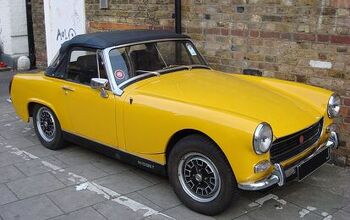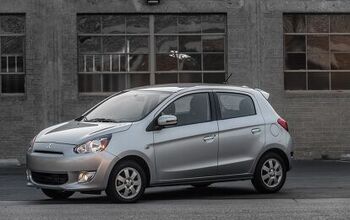QOTD: What Dead Car Brand Would You Resurrect Today?

Lately, I’ve taken you back in time when it’s my turn to offer up a Question of the Day. Today is no exception, as we’re going to discuss the past and the future at the same time. Now, while your head is spinning and you reach for a VHS copy of Back to the Future, allow me to explain.
We’re going to discuss the car brand you’d like to resurrect, and the models it would offer today. Sound like fun?
Automakers come and go through the years, and there’s usually a glaring reason for their demise. Right now you’re thinking of the list of brands taken by the Recession of 2008, aka the General Motors fire sale and Ford Clearance Event. Saab, Hummer, Pontiac, Oldsmobile, Saturn, Mercury, Plymouth, Mitsubishi and I’ll stop there.
We here at the Internet Car Enthusiast Club of Antiquities and Good Ideas usually have suggestions for these deceased manufacturers. The ideas would, if taken seriously and at the appropriate time, have saved the company and prevented its demise. Now is your chance to bring one of them back, virtually.
Since this whole exercise could go awry as easily as a startup electric car firm, there are boundaries to your selections today.
- You may pick one and only one car brand to bring back from the dead.
- The brand you pick is granted a decent reputation, sufficient dealer coverage, and some enthusiasm from the American public in 2017, regardless of which brand you choose.
- Say why you’d bring the brand back to life in today’s world, and which things it would sell. Statements like “Because I liked the Mercury Montego from 1977” are not valid here.
Those rules in place, I can submit to you my choice, and it’s not what you’re expecting. The brand I’d bring to life in 2017 is…
American Motors, or AMC if we’re being casual. In 2017, the perfect storm has readied North America for Kenosha, Wisconsin-built AMCs.
The company had the same quirky nature Subaru now sells by the gallon, and their 4×4 crossover vehicle ideals were around all the way back in 1979. So far ahead of the game, and yet so unappreciated in their time. Eagle is their 2017 crossover line, with model variations and trim names as secondary badging. The Eagle Wakefield, Wabigon, and Wabikon are all crossovers of increasing size (see what I did there?), and there are other sedan and wagon models filling out a full lineup. There’s also an all-wheel-drive minivan, the AMC Camelot, to bring competition to former spouse Chrysler. Sales success and massive profits? I think so.
Which automaker would you resurrect in 2017?
[Image: CZ marlin/ Wikimedia Commons ( CC BY-SA 4.0)]

Interested in lots of cars and their various historical contexts. Started writing articles for TTAC in late 2016, when my first posts were QOTDs. From there I started a few new series like Rare Rides, Buy/Drive/Burn, Abandoned History, and most recently Rare Rides Icons. Operating from a home base in Cincinnati, Ohio, a relative auto journalist dead zone. Many of my articles are prompted by something I'll see on social media that sparks my interest and causes me to research. Finding articles and information from the early days of the internet and beyond that covers the little details lost to time: trim packages, color and wheel choices, interior fabrics. Beyond those, I'm fascinated by automotive industry experiments, both failures and successes. Lately I've taken an interest in AI, and generating "what if" type images for car models long dead. Reincarnating a modern Toyota Paseo, Lincoln Mark IX, or Isuzu Trooper through a text prompt is fun. Fun to post them on Twitter too, and watch people overreact. To that end, the social media I use most is Twitter, @CoreyLewis86. I also contribute pieces for Forbes Wheels and Forbes Home.
More by Corey Lewis
Latest Car Reviews
Read moreLatest Product Reviews
Read moreRecent Comments
- Jalop1991 In a manner similar to PHEV being the correct answer, I declare RPVs to be the correct answer here.We're doing it with certain aircraft; why not with cars on the ground, using hardware and tools like Telsa's "FSD" or GM's "SuperCruise" as the base?Take the local Uber driver out of the car, and put him in a professional centralized environment from where he drives me around. The system and the individual car can have awareness as well as gates, but he's responsible for the driving.Put the tech into my car, and let me buy it as needed. I need someone else to drive me home; hit the button and voila, I've hired a driver for the moment. I don't want to drive 11 hours to my vacation spot; hire the remote pilot for that. When I get there, I have my car and he's still at his normal location, piloting cars for other people.The system would allow for driver rest period, like what's required for truckers, so I might end up with multiple people driving me to the coast. I don't care. And they don't have to be physically with me, therefore they can be way cheaper.Charge taxi-type per-mile rates. For long drives, offer per-trip rates. Offer subscriptions, including miles/hours. Whatever.(And for grins, dress the remote pilots all as Johnnie.)Start this out with big rigs. Take the trucker away from the long haul driving, and let him be there for emergencies and the short haul parts of the trip.And in a manner similar to PHEVs being discredited, I fully expect to be razzed for this brilliant idea (not unlike how Alan Kay wasn't recognized until many many years later for his Dynabook vision).
- B-BodyBuick84 Not afraid of AV's as I highly doubt they will ever be %100 viable for our roads. Stop-and-go downtown city or rush hour highway traffic? I can see that, but otherwise there's simply too many variables. Bad weather conditions, faded road lines or markings, reflective surfaces with glare, etc. There's also the issue of cultural norms. About a decade ago there was actually an online test called 'The Morality Machine' one could do online where you were in control of an AV and choose what action to take when a crash was inevitable. I think something like 2.5 million people across the world participated? For example, do you hit and most likely kill the elderly couple strolling across the crosswalk or crash the vehicle into a cement barrier and almost certainly cause the death of the vehicle occupants? What if it's a parent and child? In N. America 98% of people choose to hit the elderly couple and save themselves while in Asia, the exact opposite happened where 98% choose to hit the parent and child. Why? Cultural differences. Asia puts a lot of emphasis on respecting their elderly while N. America has a culture of 'save/ protect the children'. Are these AV's going to respect that culture? Is a VW Jetta or Buick Envision AV going to have different programming depending on whether it's sold in Canada or Taiwan? how's that going to effect legislation and legal battles when a crash inevitibly does happen? These are the true barriers to mass AV adoption, and in the 10 years since that test came out, there has been zero answers or progress on this matter. So no, I'm not afraid of AV's simply because with the exception of a few specific situations, most avenues are going to prove to be a dead-end for automakers.
- Mike Bradley Autonomous cars were developed in Silicon Valley. For new products there, the standard business plan is to put a barely-functioning product on the market right away and wait for the early-adopter customers to find the flaws. That's exactly what's happened. Detroit's plan is pretty much the opposite, but Detroit isn't developing this product. That's why dealers, for instance, haven't been trained in the cars.
- Dartman https://apnews.com/article/artificial-intelligence-fighter-jets-air-force-6a1100c96a73ca9b7f41cbd6a2753fdaAutonomous/Ai is here now. The question is implementation and acceptance.
- FreedMike If Dodge were smart - and I don't think they are - they'd spend their money refreshing and reworking the Durango (which I think is entering model year 3,221), versus going down the same "stuff 'em full of motor and give 'em cool new paint options" path. That's the approach they used with the Charger and Challenger, and both those models are dead. The Durango is still a strong product in a strong market; why not keep it fresher?



































Comments
Join the conversation
delorean.com/dmc-texas.htm
I would say .. TVR .. but they are back with new "more tamed" stuff .. so .. Saab for sure .. there's lack of oryginality nowadays , .. and they were "quirky" cool cars ..